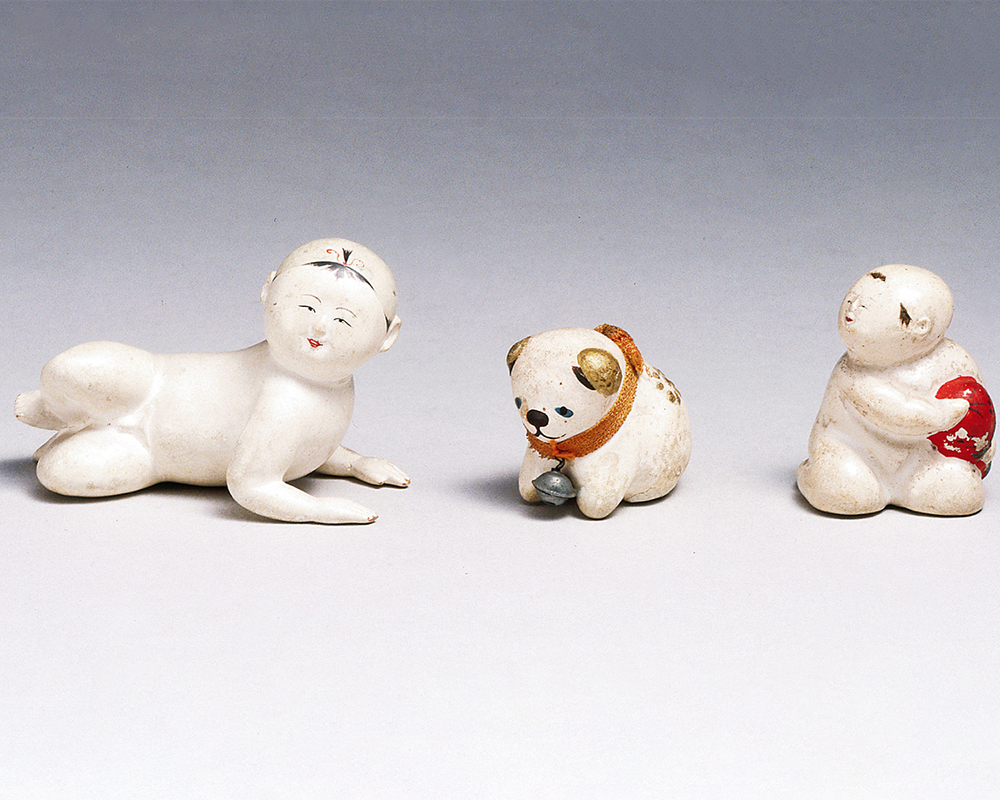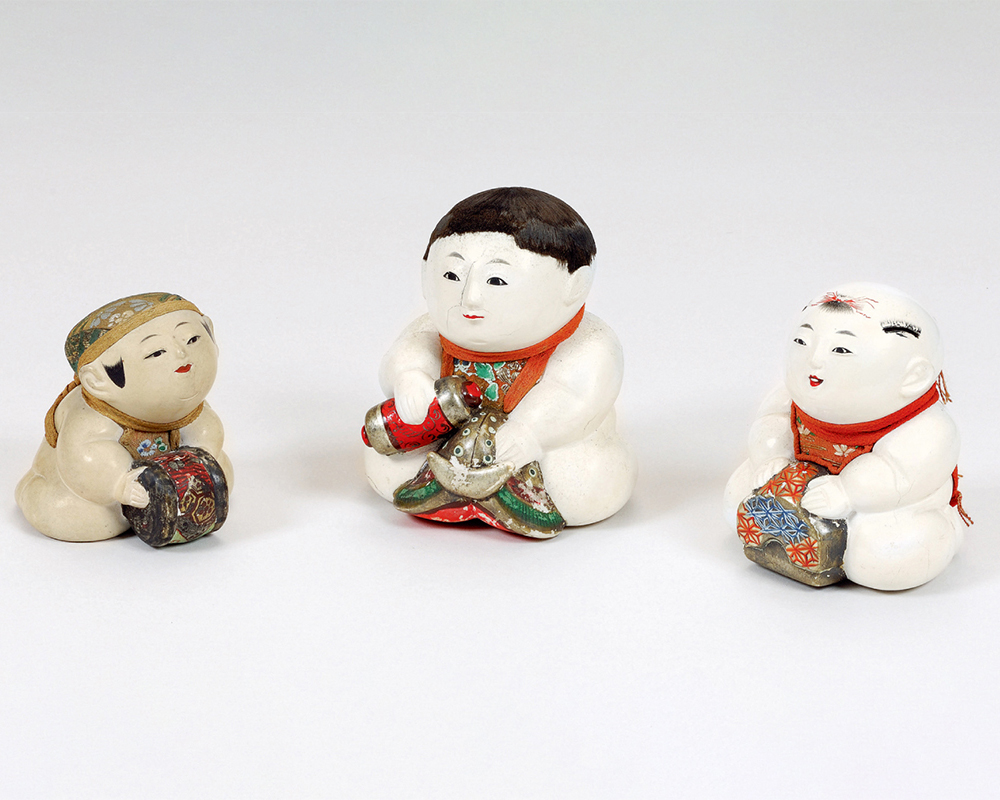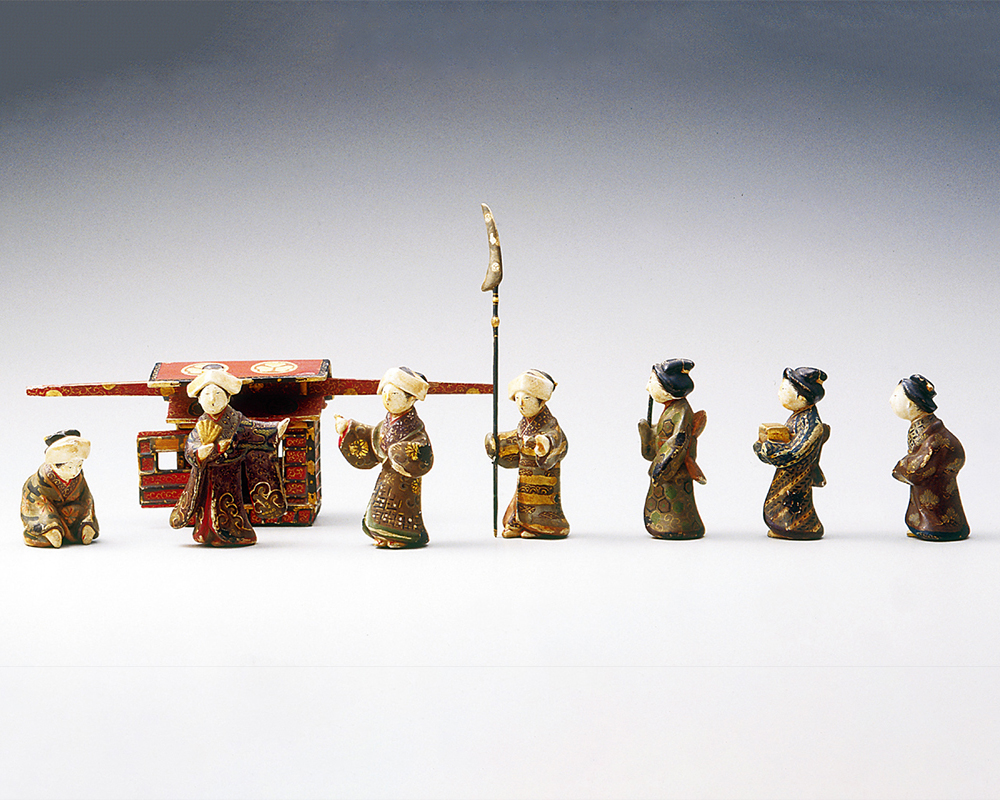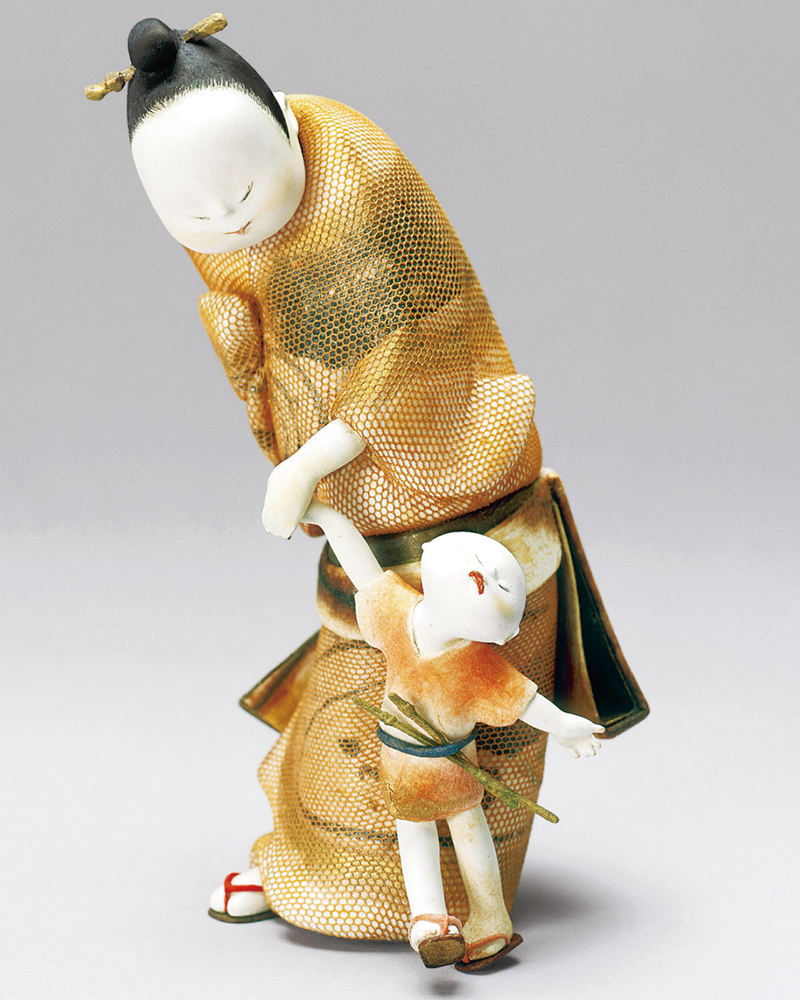Naked Saga crawling, pillow child, dog
(The Naked Ones Crawling, The Pillow Boy, The Dog)
Country
Japan
Era
Edo period (18th century)
Traits
Wood carving with chalk powder
Number of members
3 bodies
Law
Crawl/Length 5.5 cm, Pillow/Height 3.3 cm
Dog/Height 2.4 cm
Commentary
Among Saga dolls, small dolls made to look like young children, either naked or clothed, are called "hadaka Saga." They are thought to be descended from older dolls, as their shape is similar to that of "hajiko," dolls that carry the impurity of a baby. They are made with proportions close to the actual body shape of a child, so they are probably closely related to the desire to keep children healthy. One theory is that they are also precursors to Gosho dolls, as their appearance is similar, but this is not certain. The motifs are limited, such as crawling babies and dogs, as seen here.
Imperial Palace Dolls: Taiko, Kabuto, and Treasure Box
(Puppets: Drum, Helmet, and Treasure Box)
Country
Japan
Era
Edo to Meiji Period (18th to 19th Centuries)
Traits
Wood carving with chalk powder
Number of members
3 bodies
Law
Drum/height 8.5 cm, helmet/height 11.5 cm
Treasure box/Height 10.0 cm
Commentary
These dolls are in the form of adorable naked boys, and have been made in Kyoto since the Edo period. They are known as "Imperial Palace Dolls" or "Souvenir Dolls" because feudal lords would bring them back as gifts in return for the Imperial Palace when they made alternate attendance trips to Edo. They are also called "Shironikku" (white meat) or "Atama-dai" (large head) due to their pure white, large heads and plump bodies. They are carved from paulownia wood or made from a mixture of paulownia sawdust and glue, and then finished by painting whitewash on top. They often wear belly wraps or hoods, and are often holding auspicious items such as toys or treasure boxes. Above all, their innocent expressions and gestures make them one of the most popular antique Japanese dolls.
Saga Doll "Wedding"
(Saga Dolls "The Bride")
Country
Japan
Era
Edo period (18th-19th centuries)
Traits
Wood carving with chalk powder
Number of members
1 set
Law
Bride/Height 5.0 cm
Commentary
Although they are tiny dolls, each one is carved with wood and decorated with a pattern made from raised chalk powder, then painted. This type of painting method is a technique used in Buddhist statue carving, and is said to have started as a hobby for Buddhist sculptors. There are also larger Karakuri dolls, such as a 25cm tall Chinese child shaking its head, but this Saga Doll "Bride" is extremely small, and yet the ladies-in-waiting who accompany the bridal procession have rich expressions and gestures, making it a delicate piece of work.
Miharu Doll
(Miharu doll)
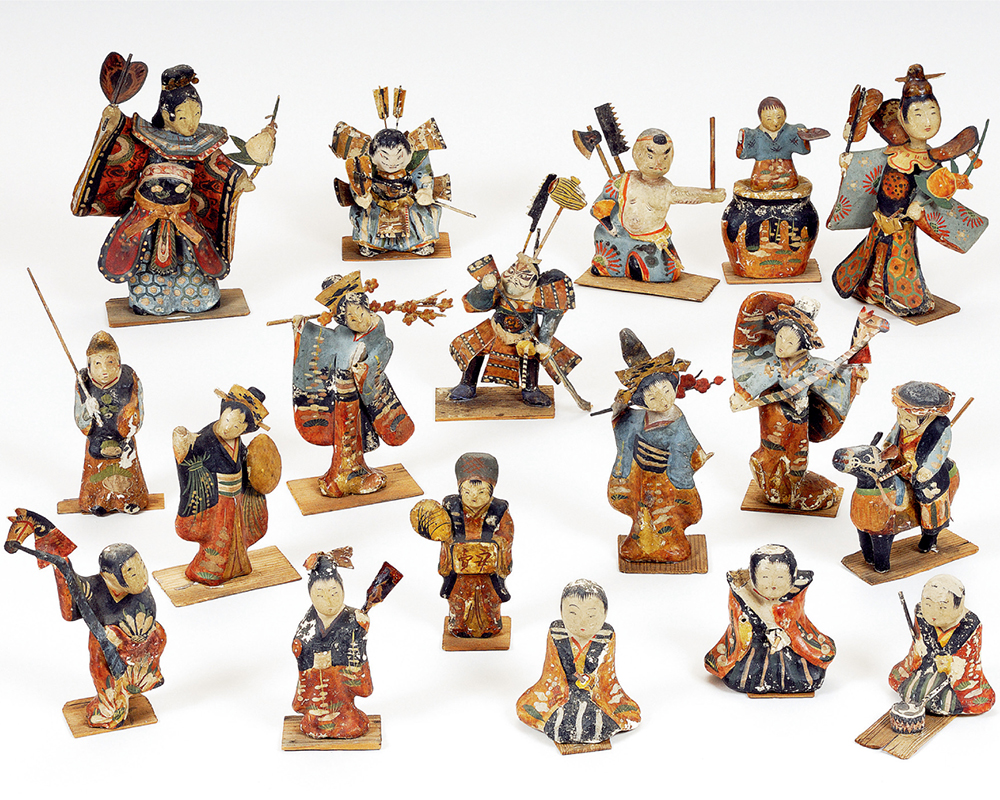
Country
Japan
Era
Edo to Meiji Period (18th to 19th Centuries)
Traits
Paper Mache
Number of members
19 bodies
Law
Height 10.0 cm - 24.4 cm
Commentary
These are local dolls made as souvenirs in the Miharu region of Fukushima Prefecture. They are said to have started in the Edo period when a feudal lord sent a group of doll makers from Edo to make them. They are made using the paper-mache technique, in which Japanese paper is pasted onto a wooden mold, cut down the middle to remove the inner mold, and the outer mold is then reattached. The reason why many different dolls can be made from the same mold is because the doll's belongings (flower branches, hats, tools, etc.) are later freely attached, a process known as "attraction," which allows for a truly rich world to unfold, from storybook protagonists to historical figures and ordinary townsfolk. With their pale colors, playful expressions, and scraps of willow wood attached to the feet as a stand, these dolls are charming in their carefree lightness.
Grass dew
(Souro)

author
Hori Ryujo
Years of birth and death
1897-1984
Country
Japan
Era
1954 (Showa 29)
Traits
Wood carving, paulownia wood, chalk, cloth and paper
Number of members
1 body
Law
Height 30.0 cm
Commentary
Hori Ryujo was born in Sakura, Chiba Prefecture. She first studied painting, but at the age of 30, she started making dolls and joined the Dontakusha doll creation group organized by Yumeji Takehisa. She participated in the Kojutsukai and Doho Bijutsuin, and was a central figure in the doll art movement in the early Showa period, which sought to elevate dolls to the level of art. She was also a pioneer among female doll artists. In 1955, she was recognized as one of the first holders of the Important Intangible Cultural Property "Costume Dolls." Her works are carved from wood and modeled with paulownia plastic, and dressed in cloth that she collected or dyed and woven herself. This work is also made using the Kimekomi method, in which whitewash is applied to carved paulownia plastic, and then cloth and paper are pasted in. The figure is of a neat and tidy woman, and has a different atmosphere from Yanagi's other dolls, which are modeled on dignified and powerful women. Donated by Fumiko Yonahara in 2006.
Dinner time
(Yuugeoki)
author
Sonoo Noguchi
Years of birth and death
1907-1996
Country
Japan
Era
1967 (Showa 42)
Traits
Wood core, paulownia wood, chalk powder, cloth and paper
Number of members
1 body
Law
Height 15.0 cm
Commentary
Noguchi Sonoo was born in Tokyo. At the age of 30, he joined Hori Ryujo's doll school, where he continued to create witty and unique dolls. Later, he founded the Soenkai doll school, where he also focused on training the next generation of dolls. In 1986, he was designated an Important Intangible Cultural Property for "Costume Dolls." This doll has Sonoo's unique rice ball-shaped head and small mouth, and humorously expresses the tender affection of a mother holding her fussy child's hand. Sonoo is said to have loved watching ordinary people, and with his keen observational skills, he was able to accurately capture the state of people's hearts and create his dolls.
